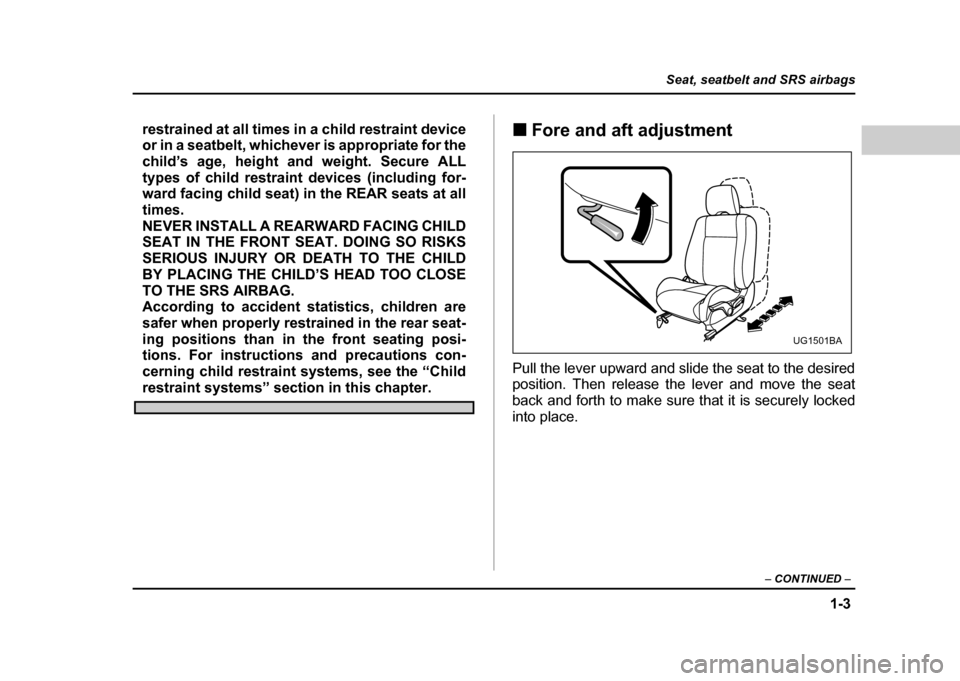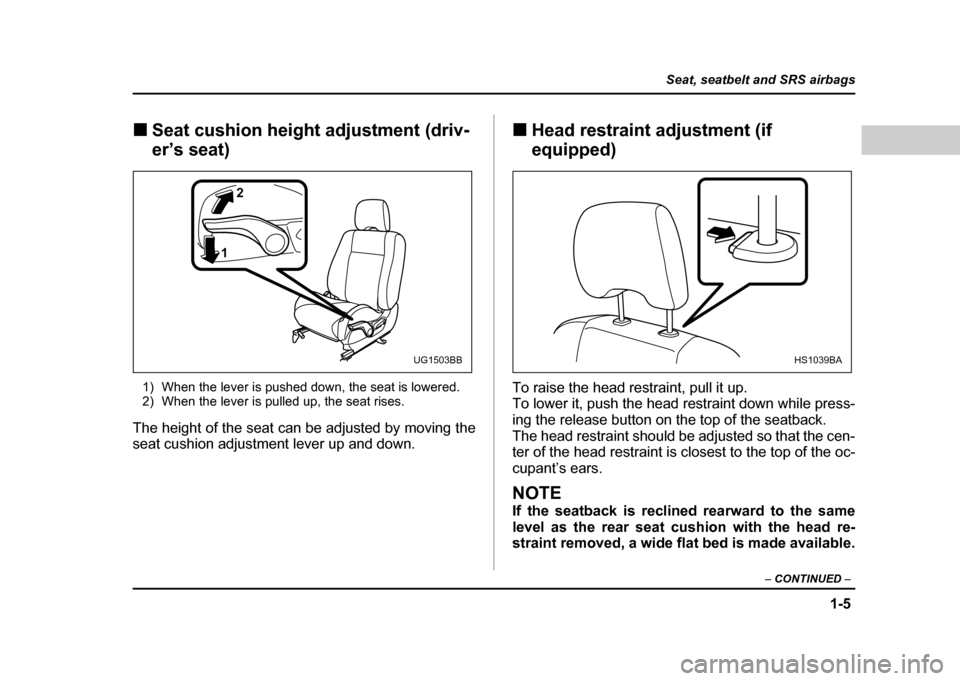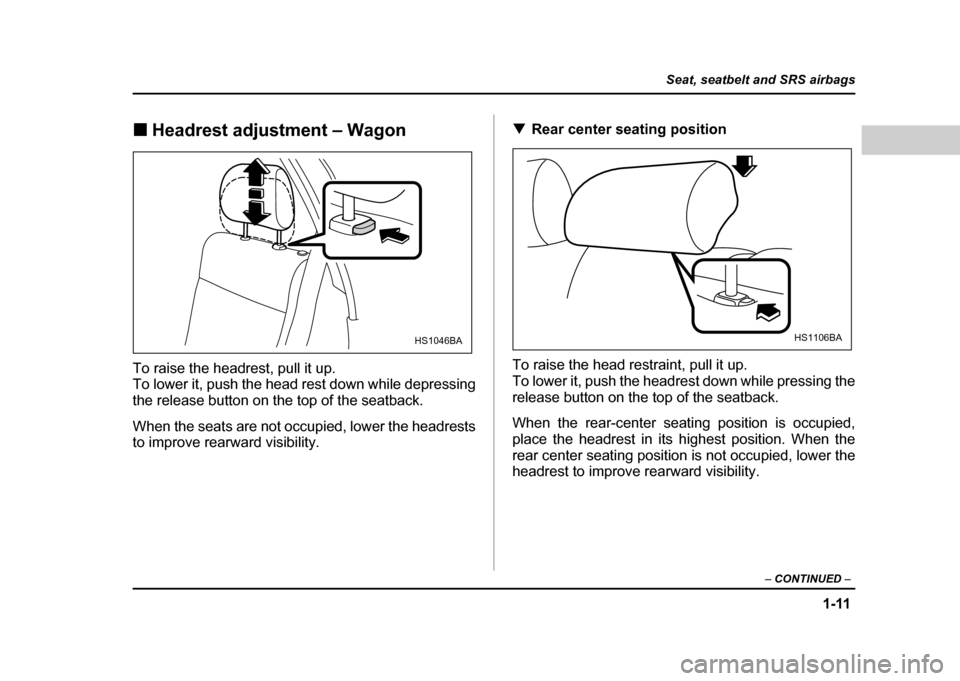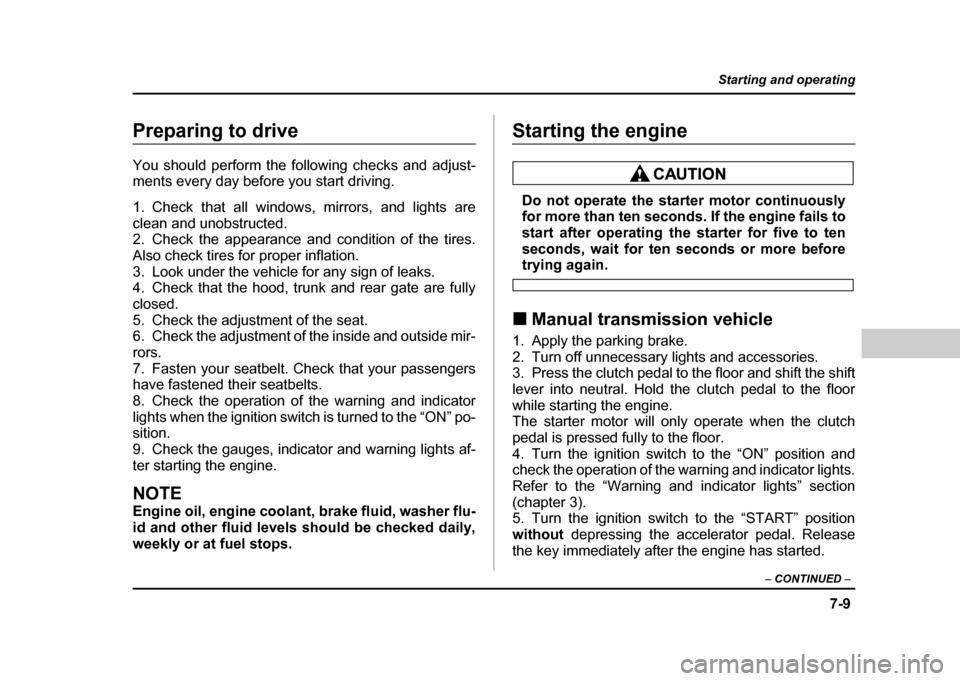2004 SUBARU IMPREZA WRX seat adjustment
[x] Cancel search: seat adjustmentPage 28 of 491

1-1
1
Seat, seatbelt and SRS airbags
Front seats .................................................... 1-2 Fore and aft adjustment ................................... 1-3
Reclining the seatback ..................................... 1-4
Seat cushion height adjustment (driver’s seat) 1-5
Head restraint adjustment (if equipped) ......... 1-5
Active head restraint (if equipped) .................. 1-6
Seat heater (if equipped) .............................. 1-7
Rear seats ..................................................... 1-8 Armrest (if equipped) ........................................ 1-9
Headrest adjustment – Wagon ........................ 1-11
Folding down the rear seat – Wagon .............. 1-12
Seatbelts ....................................................... 1-13 Seatbelt safety tips ........................................... 1-13
Emergency Locking Retractor (ELR) .............. 1-14
Automatic/Emergency Locking Retractor (A/ELR) ............................................................ 1-15
Seatbelt warning light and chime ............... 1-15
Fastening the seatbelt ...................................... 1-15
Seatbelt maintenance ....................................... 1-27
Front seatbelt pretensioners ....................... 1-27 System monitors ............................................... 1-29
System servicing .............................................. 1-29
Precautions against vehicle modification ...... 1-30
Child restraint systems ................................ 1-31 Where to place a child restraint system ......... 1-33
Choosing a child restraint system .................. 1-34
Installing child restraint systems with A/ELR seatbelt ............................................................ 1-35
Installing a booster seat ................................... 1-40
Installation of child restraint systems by use of lower and tether anchorages (LATCH) 1-42 Top tether anchorages ..................................... 1-46
SRS airbag (Supplemental Restraint System airbag) 1-52Vehicle with driver’s and front passenger’s SRS airbags and lap/shoulder restraints ..... 1-52
SRS frontal airbag ............................................ 1-56
SRS side airbag (if equipped) .......................... 1-64
SRS airbag system monitors ........................... 1-72
SRS airbag system servicing .......................... 1-73
Precautions against vehicle modification ...... 1-74
Page 30 of 491

1-3
Seat, seatbelt and SRS airbags
– CONTINUED –
restrained at all times in a child restraint device
or in a seatbelt, whichever is appropriate for the
child’s age, height and weight. Secure ALL
types of child restraint devices (including for-
ward facing child seat) in the REAR seats at all times.
NEVER INSTALL A REARWARD FACING CHILD SEAT IN THE FRONT SEAT. DOING SO RISKS
SERIOUS INJURY OR DEATH TO THE CHILD
BY PLACING THE CHILD’S HEAD TOO CLOSE
TO THE SRS AIRBAG.
According to accident statistics, children are
safer when properly restrained in the rear seat-
ing positions than in the front seating posi-
tions. For instructions and precautions con-
cerning child restraint systems, see the “Child
restraint systems” section in this chapter. !
Fore and aft adjustment
Pull the lever upward and slide the seat to the desired
position. Then release the lever and move the seat
back and forth to make sure that it is securely locked
into place.
UG1501BA
Page 32 of 491

1-5
Seat, seatbelt and SRS airbags
– CONTINUED –
!Seat cushion height adjustment (driv- er’s seat)
1) When the lever is pushed down, the seat is lowered.
2) When the lever is pulled up, the seat rises.
The height of the seat can be adjusted by moving the
seat cushion adjustment lever up and down. !
Head restraint adjustment (if
equipped)
To raise the head restraint, pull it up.
To lower it, push the head restraint down while press-
ing the release button on the top of the seatback.
The head restraint should be adjusted so that the cen-
ter of the head restraint is closest to the top of the oc-
cupant’s ears.
NOTE
If the seatback is reclined rearward to the same
level as the rear seat cushion with the head re-
straint removed, a wide flat bed is made available.
2
1
UG1503BBHS1039BA
Page 38 of 491

1-11
Seat, seatbelt and SRS airbags
– CONTINUED –
!Headrest adjustment – Wagon
To raise the headrest, pull it up.
To lower it, push the head rest down while depressing
the release button on the top of the seatback.
When the seats are not occupied, lower the headrests
to improve rearward visibility. !
Rear center seating position
To raise the head restraint, pull it up.
To lower it, push the headrest down while pressing the
release button on the top of the seatback.
When the rear-center seating position is occupied,
place the headrest in its highest position. When the
rear center seating position is not occupied, lower the
headrest to improve rearward visibility.
HS1046BAHS1106BA
Page 278 of 491

7-9
Starting and operating
– CONTINUED –
Preparing to drive
You should perform the following checks and adjust-
ments every day before you start driving.
1. Check that all windows, mirrors, and lights are
clean and unobstructed.
2. Check the appearance and condition of the tires.
Also check tires for proper inflation.
3. Look under the vehicle for any sign of leaks.
4. Check that the hood, trunk and rear gate are fully
closed.
5. Check the adjustment of the seat.
6. Check the adjustment of the inside and outside mir-
rors.
7. Fasten your seatbelt. Check that your passengers
have fastened their seatbelts.
8. Check the operation of the warning and indicator
lights when the ignition switch is turned to the “ON” po-sition.
9. Check the gauges, indicator and warning lights af-
ter starting the engine.
NOTE
Engine oil, engine coolant, brake fluid, washer flu-
id and other fluid levels should be checked daily,
weekly or at fuel stops.
Starting the engine
Do not operate the starter motor continuously
for more than ten seconds. If the engine fails to
start after operating the starter for five to ten
seconds, wait for ten seconds or more before
trying again.
! Manual transmission vehicle
1. Apply the parking brake.
2. Turn off unnecessary lights and accessories.
3. Press the clutch pedal to the floor and shift the shift
lever into neutral. Hold the clutch pedal to the floor
while starting the engine.
The starter motor will only operate when the clutch
pedal is pressed fully to the floor.
4. Turn the ignition switch to the “ON” position and
check the operation of the warning and indicator lights.
Refer to the “Warning and indicator lights” section (chapter 3).
5. Turn the ignition switch to the “START” position
without depressing the accelerator pedal. Release
the key immediately after the engine has started.
Page 484 of 491

14-5
Index
Seatbelt pretensioners
.......................................1-27
Seats ........................................................................... 1-2
Turn signal light and parking light ...................11-70
Front-wheel drive warning light ..............................3-25
Fuel .................................................................................... 7-2
Economy hints ........................................................ 8-2
Filler lid and cap ..................................................... 7-4
Gauge .................................................................. 3-9, 3-16
Requirements .......................................................... 7-2
Fuses ................................................................................ 11-60
Fuses and circuits ....................................................... 12-6
G
GAWR (Gross Axle Weight Rating) .....................8-20
Glove box ........................................................................ 6-6
GVWR (Gross Vehicle Weight Rating ) .............8-20
H
Hazard warning flasher ............................................. 3-6
Headlight beam leveler ............................................. 3-33
Headlight indicator light ............................................3-27
Headlights ......................................................... 3-29, 11-66
Headrest adjustment (Wagon) ..............................1-11
Head restraint adjustment (Front) .......................1-5
Heater operation .......................................................... 4-6
High beam indicator light ..........................................3-26
High mount stop light ................................................. 11-78Horn
.. .. ... .. ... ... .. ... .. ... ... .. ... ... .. ... .. ... ... .. ... ... .. ... .. ... ... .. ... ... .. .. 3-5 0
Hose and connections ............................................... 11-19
I
Ignition switch ............................................................... 3-3
Illuminated entry ........................................................... 2-8
Illumination brightness control ...............................3-32
Indicator light High beam ................................................................ 3-26
Selector lever position ......................................... 3-26
Turn signal ............................................................... 3-26
Inside mirror ................................................................... 3-44
Intercooler water spray ............................................. 11-53
Warning light ........................................................... 3-25
Switch ........................................................................ 3-43
Internal trunk lid release handle ............................2-26
J
Jack and jack handle ................................................. 9-24
Jump starting ................................................................. 9-14
KKey Interlock release .................................................... 3-5
Number ...................................................................... 2-3
Reminder chime ..................................................... 3-4